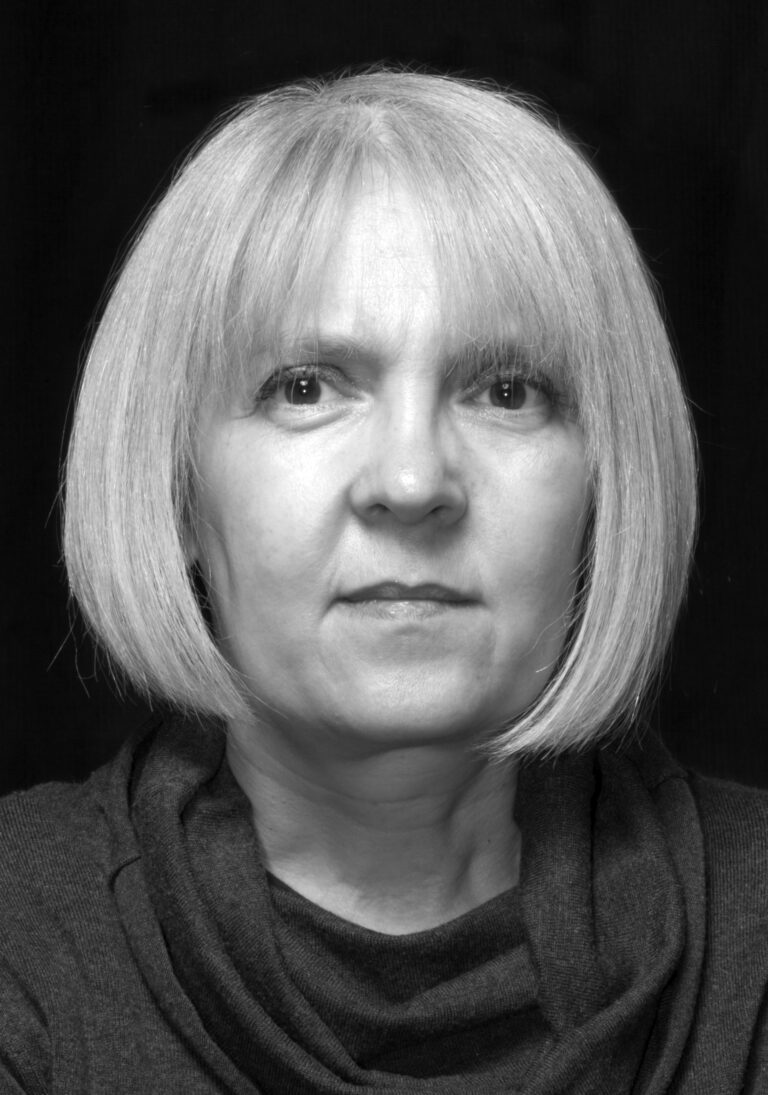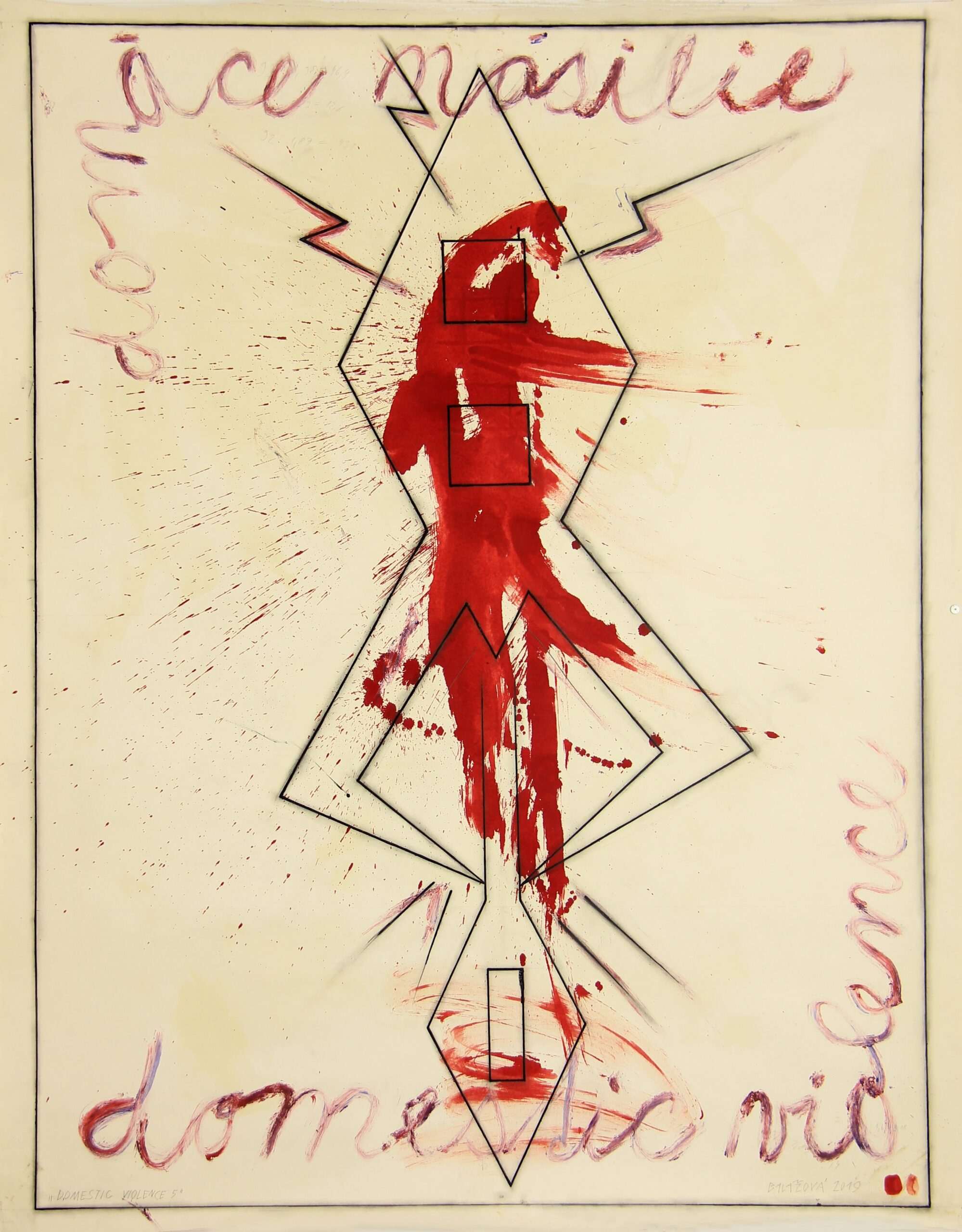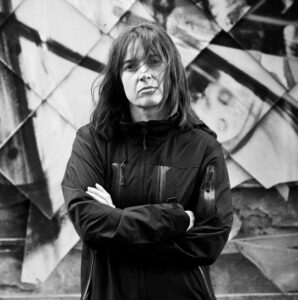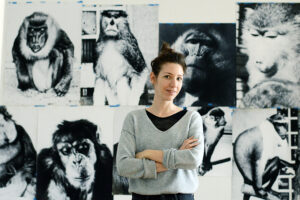Mária Balážová

– born in 1956 in Trnava – studied at the School of Applied Arts in Bratislava from 1972 to 1978 and at the faculty of costume design at the Academy of Performing Arts in Bratislava from 1978 to 1984. For her drawing Lexicon 1, she received the Honorable Mention Award at the Drawing 1990 exhibition in Provo, USA. In 1992, her drawings were selected by an international jury for the 5th International Triennale of Drawing exhibition in Wroclaw. Paintings from the Snake Geometry series are displayed as part of the exhibition Eine kurze Geschichte zur Malerei, Leverkusen, 2001, as well as in the exhibition Contemporary Slovak Art 1960-2000, Ljubljana, City Art Museum, 2007. Her drawing Unpaid Domestic Work 1 won the Honorary Mention Award at the International Drawing Biennale India 2018-19. She has had several solo exhibitions: Tucet, East Slovak Gallery, Košice, 2001, Nadowesioux, Bratislava City Gallery, 2001, Hidden Charm of Painting, České Budějovice, House of Art, 2002, and she participated in group exhibitions in Czechia, Hungary, Germany, Romania, Poland, Japan, Spain, Canada, Estonia or Norway. Since 1997 she has been a university professor at the University of Trnava and in 2004 she was habilitated as an associate professor at the Academy of Fine Arts in Bratislava. Since 1998, she has been a member of the Club of Concretists. Her husband is the painter Blažej Baláž. She lives in Trnava.
At the beginning of my work I was fascinated by the world’s diversity and the coexistence of its various forms in symbiosis with each other (the Lexicons series). In the sketches for the Lexicons series drawings from 1991, there appeared a character that I had discovered by chance and made mine – a snake from a playing card containing native American motives. To me it represented an ambivalent symbol that embodied multiple meanings in different cultural contexts. I was attracted by its ambiguity.
In the process of searching for the most succinct artistic abbreviation, the snake head – stylised into a rhombus with two adjacent rectangles – generated one central symbol. By reduction, it took the form of a female symbol, a rhombus with a vertical slit. Later it acquired the status of a delegate of my personal mythology. It brought me the opportunity to enrich my artistic statement with new levels of content with a clearly feminist meaning. The logic of encoding the themes of complementarity of the sexes and their mutual interactivity resulted in the expansion of my sign archive with a derivation of the male sign within a post-geometric language. The reduced colour palette corresponded to my psychological state at the time, after 1993, when the world did not seem colourful to me and I wanted to express my feeling in an uncompromising way, to intensify the impact on the viewer.
I had already developed this emphasis on the abstracted purity of form and shape during my high school studies at the School of Applied Art. Constructed forms were therefore not unfamiliar to me. After a lesson on postmodernism, my work would unceasingly confront geometric abstraction and seek to expand its possibilities towards expressing meanings that were previously unfamiliar to it. In the early days of creating the vast series of sign-based Snake Geometries on grey background, abstract painting personified an expression of order for me, ofdetachment from a stressful experience of a medical intervention that emotionally traumatised me for several years. Realistic expression never quite suited me; it seemed unrefined to me, lacking in exploration. The cleaned up snake head symbols within a reduced form of the female symbol grouped around the centre in a closed, mandala-like structure sought order and balance. In the form of ornamental neologisms, they were also an attempt to rehabilitate the ornament, denounced by the modernists. In specific constellations, these signs would later comment on various social, historical and cultural moments. In the latest phase of my work, I adopted expressive features and signature that the rendering of the tense themes demanded.
I usually start my work with sketches, the stimuli go straight from my head to my hand. I rework these into forms without any characteristic signature, which is a demanding and disciplined process. During this process, however, happen exciting modifications of the form, which I find
both exhilarating and exhausting. The details of the form are direct interpreters of the content. Creating templates takes a lot of time; I usually work in the evenings and at night, nothing distracts me then. I create in stages, in a fragmented manner, because I the only continuous block of time I have that can be dedicated just for creative work is during the holidays. At the beginning of my professional career I didn’t expect to be pedagogically active. But it is being active in this sphere that gives me freedom in the field of free art, as it makes me independent from commercial pressure. In the small-town environment otherwise poor in motivational stimuli, where I live with my husband, painter Blažej Baláž, we find a boost mostly in the acceptance of our work in the form of participation in various art competitions. Teaching also forces me to be active and to keep re-evaluating my own development. However, I do not create for pleasure, rather out of necessity caused by emotional overflow. I feel a challenge to express my opinion, in the belief that I will draw attention to something that I believe requires a social solution.
I have long been provoked by the persistent forms of oppression, of superiority over women. I’ve been covering this in the series Parliamentary Feminist Tread, Unpaid Domestic Work, MultiWoman, and Domestic Violence. My topics have been, as the titles suggest, genderinequality, the oppressive stereotypes in the everyday routine-governed life and the indifference and the oblivious attitude towards domestic violence. What demands a response at the moment is the invasion of women’s reproductive freedom that we are witnessing (not only) in the US. In works from the early 1990s, to which I informally refer to as reliefs or assemblages, I emphasise the essential quality of the materials and their derived meaning, which I had previously used in the large-scale fabric sculptures Archetype and Persona. These materials of a rough, mostly rustic nature, hemp, rope, textiles, leather, wood, plastic tubes, plaster, were the first of my works to communicate proto-feminist contexts (Woman, Lola…).
Other, autobiographical moments can be heard in the Domestic Violence cycle, which is about situations and conditions that my sister and I had been witness to for a long time during our childhood. It wasn’t as gory as my rendition, but it is an ongoing emotional trauma, anxiety of psychological terror. The anxiety was related to the fear for my mother on the one hand and to the fear of my father’s physical strength and the unpredictability of his reactions on the other. I cannot erase this trauma, and that is also due to what followed, and the consequences of what, despite my father’s death, still linger in my life and make me revisit the events obsessively.
Our social culture is built on stereotypes and various forms of accepted violence that come from positions of power, both in the public and in the domestic realm. Feminism names, defines and rejects these practices. In the preoccupations of these social stereotypes I see the causes of most human failings. I observe with concern the growth of certain tendencies that invade women’s rights to make decisions about their own bodies and their reproductive freedom. It seems to me that the feminist agenda has lost none of its urgency, quite the contrary.
The text was written in collaboration with Miroslava Urbanová (2022).
1Image: Mária Balážová, Lexicon 3, 1991, 70 x 100 x cm, pencil drawing on paper.2Image: Mária Balážová, Snake geometry 8, 1996, 200 x 200 cm, oil on canvas.
3Image: Mária Balážová, Snake geometry 33 – Fatum, 2000/01, 300 x 400 cm oil on canvas.
4Image: Mária Balážová, Chaos 8 - Women's War, 2014, 302 x 485 cm, acrylic on canvas.
5Image: Mária Balážová, Persona, 1988, 273 x 100 x 65 cm, object, hemp, cotton, metal, weaving
6Image: Mária Balážová, Woman, 1991, 40 x 30 cm, wood, plaster, hemp, PVC.
7Image: Mária Balážová, Parliamentary Feminist Tread 1, 2015, 74.6 x 150 cm, digital print on polytex.
8Image: Mária Balážová, Unpaid housework 1, 2018, 120 x 180 cm, acrylic on canvas.
9Image: Mária Balážová, MultiWoman 1, 2020, 100 x 70 cm, pencil drawing, ink, color on paper.
10Image: Mária Balážová, Domestic violence 5, 2019, 190 x 150 cm, ink drawing, pencil, color on paper.
– sa narodila v roku 1956 v Trnave – v rokoch 1972 – 1978 študovala na ŠUV v Bratislave a v rokoch 1978 – 1984 na Vysokej škole múzických umení v Bratislave na oddelení kostýmového výtvarníctva. Za kresbu Lexikón 1 získala cenu Honorable Mention na výstave Drawing 1990, Provo, USA. V roku 1992 boli jej kresby vybrané medzinárodnou jury pre výstavu 5th International Triennale of Drawing vo Wroclawe. Maľby z cyklu Hadia geometria boli v roku 2001 vystavené na výstave Eine kurze Geschichte zur Malerei, Leverkusen, tiež na výstave Contemporary Slovak Art 1960-2000, Ljubljana, City Art Museum, 2007. Za kresbu Neplatené domáce práce 1 získala cenu Honorary Mention Award na výstave International Drawing Biennale India 2018-19. Realizovala viacero samostatných výstav: Tucet, Východoslovenská galéria, Košice, 2001, Nadowesioux, Galéria mesta Bratislavy, 2001, Skrytý půvab malby, České Budějovice, Dům umění, 2002 a zúčastnila sa na skupinových výstavách v Českej republike, Maďarsku, Nemecku, Rumunsku, Poľsku, Japonsku, Španielsku, Kanade, Estónsku, Nórsku. Od roku 1997 je vysokoškolskou pedagogičkou na Trnavskej univerzite, v roku 2004 habilitovala na docentku na VŠVU v Bratislave. Od roku 1998 je členkou Klubu konkretistov. Jej manželom je výtvarník Blažej Baláž. Žije v Trnave.
Na počiatku mojej tvorby ma fascinovala rôznorodosť sveta a koexistovanie jeho rôznych foriem vo vzájomnej symbióze (cyklus Lexikóny). V skiciach ku kresbám z cyklu Lexikóny v roku 1991 sa vynoril mnou náhodne objavený a prisvojený znak hada z hracej karty s motívmi pôvodných obyvateľov amerického kontinentu. Predstavoval pre mňa ambivalentný symbol, ktorý zosobňuje viaceré významy v odlišných kultúrnych kontextoch. Svojou nejednoznačnosťou ma priťahoval.
V procese hľadania čo najlapidárnejšej výtvarnej skratky sa z hlavy hada, štylizovanej do kosoštvorca s dvoma vedľa stojacimi obdĺžnikmi, vygeneroval jeden centrálny znak. Redukciou získal podobu ženského znaku, kosoštvorca s pozdĺžnou štrbinou. Neskôr nadobudol status reprezentanta mojej osobnej mytológie. Priniesol mi možnosť obohatiť autorskú výpoveď o nové obsahové roviny s jednoznačne feministickým významom. Z logiky kódovania tém komplementarity pohlaví a ich vzájomnej interaktivity vyplynulo aj rozšírenie môjho znakového mobiliáru o odvodeninu znaku muža v rámci post-geometrického jazyka. Redukovaná farebná paleta zodpovedala môjmu vtedajšiemu psychickému rozpoloženiu po roku 1993, kedy sa mi svet nezdal farebný a chcela som svoj pocit vyjadriť nekompromisne, umocniť pôsobenie na diváka.
Dôraz na abstrahovanú čistotu formy a tvaru som si vypestovala už počas stredoškolských štúdií na škole umeleckého priemyslu. Konštruované formy mi teda neboli cudzie. Po lekcii postmoderny som svojou tvorbou neustále polemizovala s geometrickou abstrakciou a snažila som sa rozšíriť jej možnosti smerom k vyjadreniu významov, ktoré jej boli dovtedy cudzie. V počiatkoch tvorby rozsiahleho cyklu znakových Hadích geometrií na šedom základe pre mňa abstraktná maľba zosobňovala výraz poriadku, odpútania sa od stresujúceho zážitku po zdravotnom zásahu, ktorý ma emocionálne traumatizoval po dobu niekoľkých rokov. Realistické predmetné vyjadrenie mi nikdy celkom nevyhovovalo, pripadalo mi polopatistické, málo objavné. Vyčistené znaky hadích hláv v redukovanej podobe ženského znaku v mandaloidnej uzavretej štruktúre sústredené okolo centra hľadali poriadok a rovnováhu. V podobe ornamentálnych novotvarov boli aj pokusom rehabilitovať modernistami zatracovaný ornament. Neskôr tieto znaky v špecifických konšteláciách komentujú rôzne spoločenské, historické a kultúrne momenty. V zatiaľ poslednej fáze mojej tvorby prijímam expresívne črty a rukopis, ktoré si stvárnenie vypätých tém vyžadovalo.
Prácu začínam zvyčajne skicami, podnety idú rovno z hlavy do ruky. Tieto prepracujem do foriem bez rukopisnej podoby, čo je náročný a disciplinovaný proces. Dejú sa pri ňom ale vzrušujúce modifikácie formy, čo ma na jednej strane veľmi baví, ale aj vyčerpáva. Detaily formy sú priamym tlmočníkom obsahu. Tvorba šablón vyžaduje dosť času, zvyčajne pracujem večer a v noci, vtedy ma nič nevyrušuje. Tvorím po etapách, útržkovito, lebo celistvý časový blok len na tvorbu mám iba cez prázdniny. Na začiatku mojej profesionálnej dráhy som nepredpokladala, že budem činná aj pedagogicky. No práve pôsobenie v tejto sfére mi dáva slobodu vo sfére voľného umenia, keďže ma robí nezávislou od komerčných tlakov. V malomestskom prostredí, inak chudobnom na motivačné podnety, kde žijem s manželom, výtvarníkom Blažejom Balážom, je nám vzpruhou predovšetkým akceptovanie nášho diela formou účasti na rôznych výtvarných súťažiach. Pedagogická činnosť ma tiež núti byť aktívnou a prehodnocovať vlastný vývoj. Netvorím však pre radosť, skôr z nevyhnutnosti vyvolanej emocionálnym pretlakom. Cítim výzvu vyjadriť svoj názor vo viere, že upozorním na niečo, čo si podľa mňa žiada spoločenské riešenie.
Dlhodobo ma provokujú pretrvávajúce formy útlaku, nadradenosti voči ženám. Spracúvam to v cykloch ako Parliamentary Feminist Tread, Neplatené domáce práce, MultiWoman, Domáce násilie. Témami sa mi stali, ako názvy napovedajú, rodová nerovnosť, ubíjajúce stereotypy v každodennom rutinne žitom živote a ignorovanie a nevšímavý postoj k domácemu násiliu. V súčasnosti si reakciu žiada siahanie na slobodu reprodukčných práv žien, ktorého sme svedkami (nielen) v USA. V prácach zo začiatku deväťdesiatych rokov, ktoré pracovne nazývam reliéfy alebo asambláže, zdôrazňujem esenciálnu kvalitu materiálov a ich derivovaný význam, ktoré som predtým použila pri tvorbe veľkorozmerných textilných plastík Archetyp a Persona. Použité materiály drsného, zväčša rurálneho charakteru, nachlpené konope, povrazy, textil, koža, drevo, plastové trubičky, sadra ako prvé z mojich prác komunikovali protofeministické kontexty (Žena, Lola…).
Iné, autobiografické momenty zaznievajú v cykle Domáce násilie, ktorý je o situáciách a stavoch, ktorých sme boli so sestrou v detstve dlhodobo svedkami. Nebolo to také krvavé ako moje stvárnenie, ale ide o pretrvávajúcu emocionálnu traumu, úzkosť z psychického teroru. Tá súvisela jednak so strachom o mamu a na druhej strane so strachom z otcovej fyzickej sily a nepredvídateľnosti jeho reakcií. Táto trauma sa mi nedá vymazať aj v spojení s tým, čo potom nasledovalo a čoho dôsledky, aj po otcovej smrti, v mojom živote ešte pretrvávajú a nútia ma stále obsedantne sa k tým udalostiam vracať.
Naša spoločenská kultúra je postavená na stereotypoch a rôznych formách akceptovaného násilia z pozície moci, a to vo sfére verejnej aj domácej. Feminizmus tieto praktiky pomenúva, definuje a odmieta. Vo fixácii týchto spoločenských stereotypov vidím príčiny väčšiny ľudských zlyhaní. So znepokojením sledujem narastanie niektorých tendencií zasahujúcich do práv žien rozhodovať o vlastnom tele a ich reprodukčnej slobode. Zdá sa mi, že feministická agenda nestratila nič na svojej naliehavosti, práve naopak.
Text bol napísaný v spolupráci s Miroslavou Urbanovou (2022).
1Obrázok: Mária Balážová, Lexikón 3, 1991, 70 x 100 x cm, kresba ceruzou na papieri.2Obrázok: Mária Balážová, Hadia geometria 8, 1996, 200 x 200 cm, olej na plátne.
3Obrázok: Mária Balážová, Hadia geometria 33 – Fátum, 2000/01, 300 x 400 cm olej na plátne.
4Obrázok: Mária Balážová, Chaos 8 - Vojna žien, 2014, 302 x 485 cm, akryl na plátne.
5Obrázok: Mária Balážová, Persona, 1988, 273 x 100 x 65 cm, objekt, konope, bavlna, kov, tkanie.
6Obrázok: Mária Balážová, Žena, 1991, 40 x 30 cm, drevo, sádra, konope, PVC.
7Obrázok: Mária Balážová, Parliamentary Feminist Tread 1, 2015, 74,6 x 150 cm, digitálna tlač na polytexe.
8Obrázok: Mária Balážová, Neplatené domáce práce 1, 2018, 120 x 180 cm, akryl na plátne.
9Obrázok: Mária Balážová, MultiWoman 1, 2020, 100 x 70 cm, kresba ceruzou, tušom, farba na papieri.
10Obrázok: Mária Balážová, Domáce násilie 5, 2019, 190 x 150 cm, kresba tušom, ceruza, farba na papieri.



